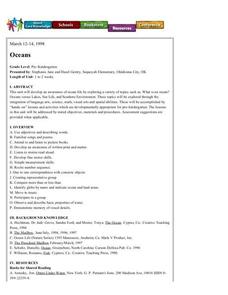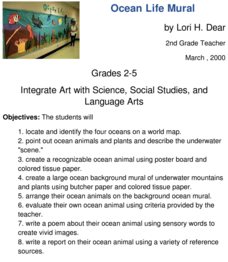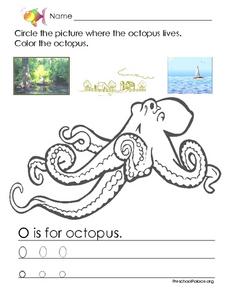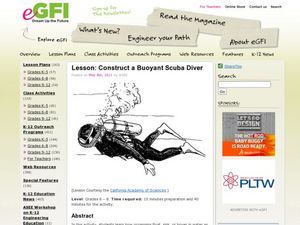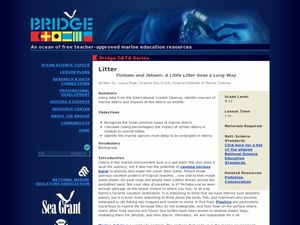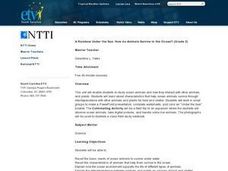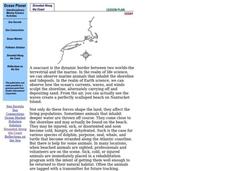Curated OER
Something's Fishy
Students study fish habits and traits. In this marine life lesson, students complete four learning centers of a fish memory game, a fish habitat study, draw and glue fish craft activity, and a fish read-a-thon. Students complete their...
Curated OER
Oceans
Students become aware of the differences between ocean water and lake water by smelling, tasting and seeing. They distinguish between land and bodies of water on a globe and gain increased awareness of oceans and life.
Curated OER
Ocean Life Mural
How many oceans can you name? First, have learners try to name as many oceans as they can, and then have them locate and identify the oceans on a world map. They create a recognizable ocean animal using poster board and tissue paper....
Sea World
Marine Animal Husbandry and Training
Step into the role of a zoo director with several activities about animal training and running a zoo. Kids calculate the amount of food each animal needs, design a habitat for penguins, decide how to breed bottlenose dolphins, and train...
NOAA
Technology I
Isn't technology great? The 12th installment of a 23-part NOAA Enrichment in Marine sciences and Oceanography (NEMO) program introduces technology that marine scientists use. Pupils take part in an activity using conductivity,...
Curated OER
Word Search: Common Seashore Plants
I really like these colorful word searches put out by The Waterford Press. Learners view 18 beautiful and accurate drawings of common seashore plants, and then must find them in a word search. An answer key is provided.
Curated OER
Word Search: Common Seashells
Here is a wordsearch on common seashells. There are 25 shell words that have to be found in the search. Each one has a colorful and accurate picture on the worksheet. An answer key is included.
Curated OER
Who Am I?
Here is a colorful worksheet that has learners look at a variety of salt water fish, then choose the name that identifies each one. The names of the fish are at the bottom of the worksheet. The pictures are colorful and accurate...
Curated OER
Who Am I?
Youngsters find these common sea plants and animals using a worksheet. Each of the plants and animals has a colorful representation on the worksheet. There is an answer key at the bottom of the worksheet that has all of plant and animals...
Curated OER
Ocean Commotion Activity - Dioramas
Groups make a model of an Ocean Commotion exhibit based on what they saw during the fieldtrip. These dioramas can be used as an informal assessment of student knowledge acquired at Ocean Commotion.
Curated OER
Number Search in Monterey Bay Aquarium
Youngsters search for an animal with body parts for each number from one to ten during a field trip to an aquarium. They count rays, fins, feet, gills, eyes, spots or anything. When they get back to the classroom, they compile their...
Curated OER
Aquatic Roots
Young scientist use reference materials to research various local aquatic plants and or animals to find out whether they are natives or exotics. They investigate their impacts on people, other animals and the environment. High schoolers...
Curated OER
Where the Octopus Lives
In this letter O worksheet, students color a large picture of an octopus. Students analyze two pictures of habitats and circle the one that shows where an octopus would live. Students trace and practice upper and lower case letter Oo.
Curated OER
Construct a Buoyant Scuba Diver
Groups of young oceanographers get to use action figures to experiment with the property of buoyancy! This memorable lesson plan provides detailed background information, a link to the laboratory worksheet, and thorough instruction...
Curated OER
Career Exploration
Students create a pamphlet, brochure, handout, or poster about a career in the marine sciences. In this marine science lesson plan, students use the Internet to research a marine science career. They create a printed media item to share...
Curated OER
Impacts to the Open Ocean
Students investigate how human beings impact ocean ecosystems. In this ocean ecosystem lesson plan, students explore how marine debris affects marine life. Internet resources are provided.
Curated OER
All About Me-I'm My Own Research Project
Third graders see how to do a research project. They understnad how to categorize information about themselves and relate it to information on sea animals for a future research project. This lesson fits in nicely with any unit on animals.
Curated OER
The Science Behind Dolphins
Students discover facts about marine mammals, specifically dolphins. In this K-2 lesson plan, students identify the different species of Cetaceans, focusing on dolphins. Students answer true/false questions regarding cetaceans and...
Curated OER
LitterFlotsam and Jetsam: A Little Litter Goes a Long Way
Students explore the concept of environmental stewardship. In this science lesson, students investigate data from the International Coastal Cleanup, identify sources of marine debris, and discover the impacts of this debris on wildlife.
Curated OER
Biodiversity
Students explore the diversity of different marine sanctuaries. In this biodiversity lesson students work in groups to explore a sanctuary.
Curated OER
Predator/Prey Activity: Fish Feeding, Environments, and General Behavior
Students explore concepts of environment and survival among different marine life, focusing on the ocean environment.
Curated OER
Sea Connections
Students, after locating different marine habitats on a globe, play a card game about ecosystems, food webs and organisms.
Curated OER
A Rainbow Under the Sea: How do Animals Survive in the Ocean?
Second graders read books, watch videos, complete worksheets and participate in class discussions about ocean animals. They, in groups, design PowerPoint presentations on selected marine animals.
Curated OER
Stranded Along The Coast
Young scholars reflect and investigate how a seacoast is the dynamic border between two worlds-the terrestrial and the marine. In the realm of life science, we can observe marine animals that inhabit the shoreline and tidepools. In the...



